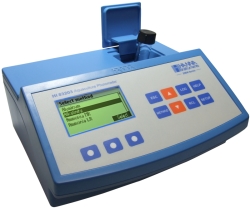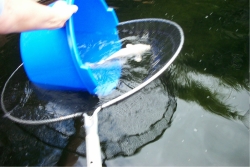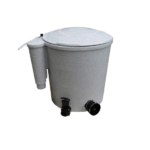This year, we have again had a very harsh and severe winter. In some cases, ponds were frozen for a prolonged period and without pond heaters to keep part of the surface free from ice, many Koi suffocated. Others, who have been weakened by the prolonged cold spell will emerge in the spring with depleted strength and not in the best of health. As a result, it is important that their environment is well looked after, they have excellent water quality and you start feeding again with wheatgerm/ multi-season feeds as soon as the temperature allows. Blood samples taken at this time of year often show the Koi to be anemic. The resumption of feeding will help them with any nutritional problems and to regain their former condition.
Some of the fish problems which are occurring at the present time is due to water toxicity. This often occurs when we have had a poor winter and a lot of debris can end up in the pond. A good clean-up and controlled water changes usually cures these problems.
Pond & Environment

- Clean and vacuum the pond.
- Strip and clean pumps.
- Check all valves and pipework – now is the time to undertake those changes before the heavier feeding starts and the filtration system builds up efficiency.
- Re-direct / re-connect waterfalls which have been bypassed during the very cold winter spells.
- Clean and flush the filters – use pond water and clean alternative biological bays at weekly intervals.
- Reinstate any reduced air supplies.
- Replace the UV clarifier tube so its at peak performance when during the summer.
- Test the water – this is most important when the feeding protocol changes (ie resumed/ increased feeding rate or food type).
- Remember that it will take time for the biological filter to build-up again.
Your Koi

Sit by the pond, have a cup of tea or coffee and just watch the Koi for a while – they will tell you if there is a problem.
- Look for any surface blemishes, marks or changes in behavior.
- If there are any changes, bowl-up and carefully inspect the Koi – invert and look at the underside of the body and the gills.
- Do not treat the pond as a matter of course.
- If you think you may have a parasite problem, check with a microscope and mucous scrape first. If it’s confirmed, select the best medication to treat the problem, bearing in mind water temperatures.
- If you find costia, remember that this is a secondary parasite and is only found on 1 or 2 unwell Koi – look for the cause.
- Keep an eye on the water temperature and feed accordingly. If temperatures look like dropping again, slow the feeding rate.
If you need any advice or have any concerns, do not hesitate to contact on 01243 698284 or 01243 572762.
The HealthyKoi Team – Rod, Gerry & Dave


